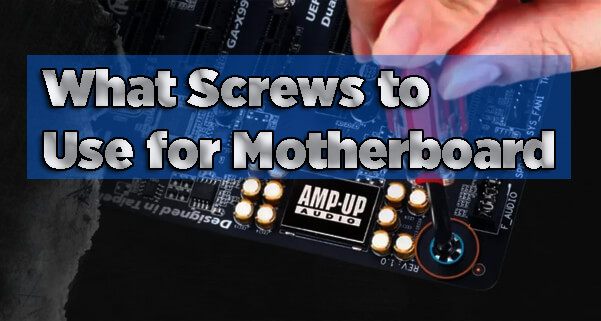When embarking on the journey of building or upgrading your PC, selecting the right components is paramount. Among these, the motherboard holds a central role, connecting all essential hardware components. Yet, one often overlooked aspect is the choice of screws used during the installation process. We share into the specifics of what screws to use for your motherboard, ensuring a smooth and secure PC build.

What Screws Should I Use for the Motherboard?
Assembling PC components is as crucial as selecting the right components themselves. With numerous pins and bolts on the motherboard, it’s easy to become bewildered about which screws to use. So, let’s delve into this matter attentively.
Standoffs:
Standoffs, as the name implies, serve the critical function of elevating your motherboard slightly off the case, preventing it from coming into direct contact with the metal chassis. Installing standoffs is a step of paramount importance, as they essentially act as a platform for mounting the motherboard within the PC case.
These components often resemble screws and play a vital role in maintaining a safe electrical balance between the metal case and the motherboard. Standoffs typically possess a hexagonal shape and manufacturers can craft them from either metal or plastic. Their size and type depend on the motherboard’s form factor.
#6-32 UNC Screws:
These screws primarily secure expansion cards inserted into the motherboard, as well as fasten the power supply and side panel of the PC case. Most motherboard standoffs are of the #6-32 UNC type, so it’s imperative to use screws that correspond to this specification for a secure fit. The more common length is 3/16 inches, but 5/16-inch long screws can also be employed.
These screws have a main diameter of 3.505mm and a thread pitch of 0.794mm. One end of this standoff features a #6-32 UNC female thread to receive a screw for securing the motherboard, while the opposite end possesses a #6-32 UNC male thread to attach to the case.
M.3 Screws:
If you encounter difficulty in obtaining #6-32 UNC screws, M.3×5 screws can be an alternative for mounting your motherboard. These are considered a universal option suitable for most standoffs. You can also use M.2 or M.4 screws as an alternative, depending on your motherboard.
Thumbscrews:
Typically measuring 7.5mm in length, thumbscrews are designed with knurled heads. Which is allowing for effortless tightening or loosening using only your fingers. They primarily serve to secure the side panel of the PC case, providing an easily accessible grip for user convenience.
M.5×10 Screws:
These screws are specifically designed for fan cases and are typically included with the fan case itself. They have a conical shape and a flat head. Manufacturers often provide four of these screws to secure fans to the case.
M.2 SSD Screws:
M.2 SSD screws are indispensable for securing M.2 drives into the motherboard’s M.2 slots.
M3 Hexagonal Head Screws:
As their name suggests, these screws are designed to secure optical drives. They bear some resemblance to 6-32 screws, leading to occasional confusion. However, a closer look reveals that the hexagonal head has a finer thread compared to the 6-32 screw.
These are the commonly used screws for various motherboard components.
Some Tips before Using Screws for a Motherboard:
You can consider reusing screws from older computers since standard cases frequently use identical screws. It’s crucial to carefully check the threading & length of these screws to ensure they fit correctly. When fastening the screws, they should go in smoothly without any resistance, securely holding the components in place. Exercise caution regarding the standoff length to prevent any issues like rattling or contact with metal parts, which could potentially result in electrical shorts and damage to the motherboard.
Users often fasten many motherboards to the case chassis using threaded brass standoffs known as Jack Screw Standoffs. Ensuring compatibility between screws and standoffs is vital; using components that don’t match can lead to loose connections and the risk of damage. Keep in mind that various motherboard types, such as ATX and MATX, may necessitate distinct screw types.
Avoid attaching the motherboard directly to the PC chassis without standoffs.
The modern design motherboard comes with a M.2 drives and it is the perfect for compact SSDs. These types of motherboard has a M.2 screw for standard drive sizes that is accourate for the mounting the drive. Expansion card screws are essential for securing expansion cards to the PC case when inserted into the motherboard’s PCIe slot.
If you find that none of the screws at your disposal fit your motherboard, consult the motherboard’s user manual for information on the required screw types. In some cases, unique cases may require specialized screws.
Safety Precautions:
Keep in mind that not all standoff holes in the PC case need to be occupied. The number of standoffs used depends on the motherboard’s design, and some standoff holes may remain empty. It’s advisable to consult the user manual, especially for cases with distinct designs that may necessitate unique screws.
In the intricate world of PC assembly, you can’t ignore the fundamental detail of choosing the screws for your motherboard. We’ve explored the types of screws, their sizes, and their critical roles in securing your motherboard.
FAQs –
Question: Do motherboards use the same screws?
Answer: Generally, motherboards use standardized screws, but specific cases and motherboard types may require slightly different screw sizes.
Question: Does a motherboard need all screws?
Answer: We recommend using all necessary screws to properly secure the motherboard, ensuring stability and grounding protection.
Question: How many screws does a motherboard need?
Answer: The number of screws a motherboard needs depends on its size and the case design. Typically, it ranges from 6 to 9 screws.
Question: What are motherboard standoff screws?
Answer: Motherboard standoff screws elevate the motherboard above the case, preventing electrical shorts and providing stability. They are an essential part of motherboard installation.
